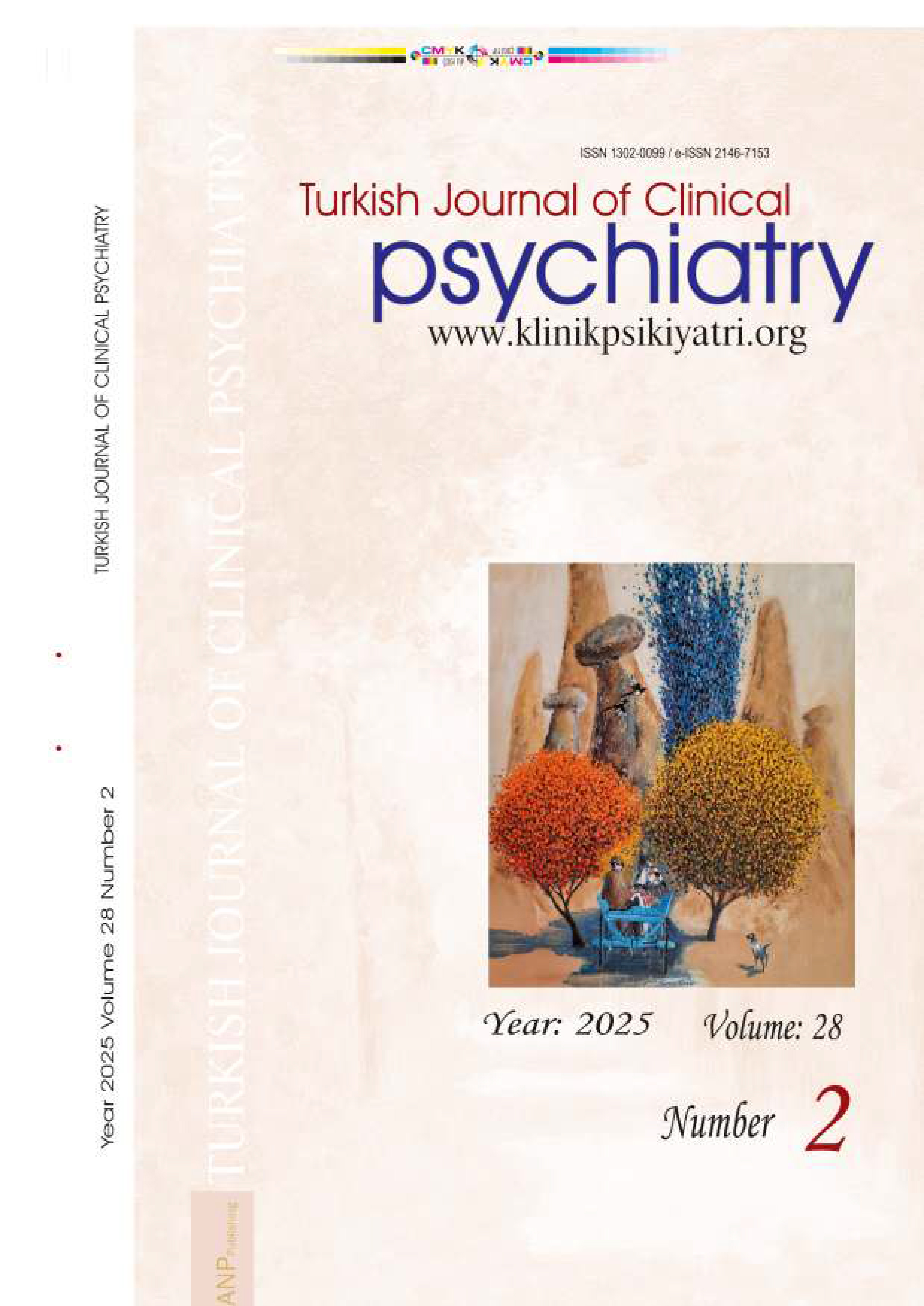





Volume: 9 Issue: 4 - 2006
| RESEARCH ARTICLE | |
| 1. | Extra Medical Ways of Help-seeking Behaviour in Patients with Depression: Can Alexithymia be a Contributing Factor? Evrim Özkorumak, Hüseyin Güleç, Samet Köse, Jeffrey Borckardt, Kemal Sayar Pages 161 - 169 Objective: Alexithymia refers to a specific disturbance in emotional processing that is manifested by difficulties in identifying and verbalizing feelings, a paucity of fantasy and dreams, and a tendency to think in a concrete, utilitarian way, and by an inability to discriminate between feelings and physical sensations. The objective of this study is to investigate whether there is any difference of alexithymia construction in the patients seeking extramedical help. Method: The sample consisted of 100 patients who were diagnosed as major depressive disorder (MDD) according to the DSM-IV criteria in five State Hospitals of Trabzon and Rize, Turkey. Participants were administered a sociodemographic questionnaire form, the Hamilton Anxiety Scale, the Hamilton Rating Scale for Depression, the 20 Item Toronto Alexithymia Scale, the Somatosensory Amplification Scale and the somatization subscale of the SCL-90R. Sociodemographic data and psychometric measures were compared among the patients who sought extramedical help and who did not. Results: Twenty-four of 100 participants sought extramedical help. Patient seeking extramedical help had significantly higher scores on the second dimension of the TAS-20 and more frequently asked help from other medical doctors. When the duration of education was controlled for, there was a significant difference on the measures of all alexithymia tests except Externally Oriented Thinking between the groups. Only Difficulty in Expressing Feelings significantly added variance in predicting extramedical help seeking behavior. Conclusion: Patients seeking extramedical help were found to have more difficulty in describing feelings and tendency to consult other medical doctors. MDD patients with alexithymia may show abnormal illness behavior and difficulty in expressing their complaints. |
| 2. | The Response to Obesity Treatment and Alexithymia Artuner Deveci, M. Murat Demet, Bilgin Özmen, Sabriye Özkay Kafesçiler, Erol Özmen, Zeliha Hekimsoy, Feyzullah Güçlü Pages 170 - 176 Objectives: Obesity is a chronic disorder and a serious public health problem. Alexithymia may be considered as a personality feature characterized by poorness of imaginary life, speech focused on actual facts and physical sensations, general inaccuracy in or paucity of the words used to express emotions, and recourse to acting out to avoid intrapsychic conflicts. In this study, it is aimed to investigate levels of alexithymia in a group of obese patients according to the success of obesity treatment. Method: The sample was consisted of 64 obese persons consecutively admitted to the Celal Bayar University Hospital Endocrinology Department. Of the whole patients, 53.1 % (n=34) was successful treatment. At the first, the trained clinical psychiatrists interviewed the patients with the Structural Clinical Interview for DSM-IV (SCID). The patients were applied to the Sociodemographic Data Form, Toronto Alexithymia Scale. The influence of body mass index (BMI) of the patients on scales scores were investigated by t-test. Results: The mean BMI was 37.9 6.0 kg/m2. The mean age was 42.4 12.1. Of the whole patients, 92.2% (n = 59) was women. 59.4% (n=38) of the patients were housewife. 42.2% (n=27) of the patients were graduated from primary school. 78.1% (n = 50) of the patients were married. Twenty-two patients (34.4%) had a current DSM-IV diagnosis. It wasn't statistically a significant difference both the succesful treatment group (p=0.096) and the unsuc- cesful treatment group (p=0.138) according the alexithymia scores in pre-treatment and post-treatment. Conclusion: In this sudy, it wasn't a significant association between success of obesity treatment and levels of alexithymia. More studies is necessary to indicate between alexithymia and treatment in obesity. |
| 3. | Factors Influencing Depressive Symptoms and Cognitive Disorders Among Elderly Mustafa İlhan, Işıl Maral, Mehmet Kitapçı, Selçuk Aslan, Nuri Çakır, M.Ali Bumin Pages 177 - 184 Objectives: The objective is to determine the risk factors for depressive symptoms and cognitive disorders among elderly evaluating essential and hormonal factors such as age, gender, educational status, health insurance, chronic disease and thyroid hormones, vitamin B12, folic acid. Method: 191 elderly living in two nursing homes in Ankara were included into the study. The demographic information questionnaire, Mini Mental State Examination test for Illiterate (MMSE) and Geriatric Depression Scale (GDS) were used for the data collection. Serum TSH, FT3, FT4 levels, vitamin B12 and folic acid levels in venous blood samples were investigated Factors which could influence depressive symptoms and cognitive disorder were evaluated with multivariate logistic regression analysis. Results: The mean age of the subjects was 76.5±8.3; 60.3% of them were female and 39.7% were male. 48.2% of the subjects had depressive symptoms and 50.8% had cognitive disorder. The depressive symptom risk was 3.75 times higher in those who had any chronic disease; 3.84 times in those who had not health insurance; 9.77 times for those who had any life event fluenced negatively his/her life; 3.01 times for those with cognitive disorder. There was 0.4 times decreased risk for the subjects living in nursing home more than a year. Cognitive disorder risk was 6.30 times higher for 75 and over age group; 6.80 times higher for those who were illiterate or not completed the primary school and 3.23 times in those with depression. Conclusion: It is required to take into consideration the determined risk factors to plan the elderly health services. |
| REVIEW | |
| 4. | Psychosocial Characteristics of Children and Adolescents on Long-Term Follow-Up Treatment of Cancer and General Principles Burcu Özbaran, Serpil Erermiş Pages 185 - 190 Childhood cancers can be defined as chronically diseases related to new treatment strategies in recent 30-40 years. Problem areas have also changed depending on increasing survival rates. Cognitive and emotional symptoms can be revealed by children and adolescents with cancer on long-term follow-up period. In this review it's aimed to investigate the psychiatric disorders, psychosocial problems of children by adaptation period to normal daily life after intensive cancer treatment. For this review 45 studies were evaluated and 34 of them were used. Pubmed search engine was used for this purpose. Cancer has long-term impacts on children by emotional and cognitive states. Children with cancer may have difficulties by adaptation to daily life and to social environment after hospitalization period. Working with the family may be helpful by coping with long-term sequels of cancer disease and its treatment. Challenging results about emotional effects of cancer on children by various studies could be made clearer by future planning researches on this area. That the cancer has effects on whole life by children and adolescents, for decreasing the negative impacts of trauma, working with the family instead of working with the child alone and realize the psychosocial factors may be very helpful. |
| CASE REPORT | |
| 5. | Sexual Aversion Disorder: A Case of Favourable Outcome and Rapid Response to Behavioral Therapy Sultan Doğan Pages 191 - 197 Sexual aversion disorder is a sexual dysfunction characterized with persistent or recurrent extreme aversion to, and avoidance of, all (or almost all) genital sexual contact with a sexual partner. It is known that it is a rare disorder and it is hard to treat. Although it entered DSM's classification in 1987, in books about sexual disorders it is not placed under its own title but discussed with sexual desire disorder, vaginusmus, dyspareunia or as a result of sexual abuse. There is a common opinion that it is seen more frequently with women and the most efficient treatment technique is the behavioral desensitization. This case report presents a 24-year-old woman, who had not touched her husband in her 4-year marriage and had not let him touch her and refused having sex naked. The patient, who was sexually abused when she was 8 or 9, had rarely had sex with her husband. The patient who was admitted to thearpy with her husband improved in a surprisingly short time. Treatment process, where "systematic desensitization" and general sexual therapy principles applied, was completed in 3 sessions. In this paper, clinical characteristics, diagnosis, treatment process of sexual aversion disorder, and factors that affected the treatment process positively were discussed. Moreover, it is emphasized that sexual aversion disorder could be treated in a surprisingly short time with proper therapy techniques and when patients are informed well. |
| 6. | Clozapine-Induced Myoclonus: A Case Report Aybala Sarıçiçek, Leyla Gülseren Pages 198 - 202 Clozapine is a potent atypical antipsychotic drug being used to treat treatment-refractory schizophrenia and has fewer extrapyramidal side effects in comparison to conventional antipsyhotic drugs. It has a weaker affinity for post-synaptic D2 receptors and exhibits its actions via D1, D4 and 5HT2 receptors. Side effects of major clinical importance include agranulocytosis, seizures, orthostasis, sedation and, hypersalivation. In addition to generalized seizures, clozapine may also produce myoclonus. Myoclonus can be defined as spontaneous, paroxysmal and irregular contractions of a muscle or muscle group. It can be focal or multi-focal. Many psychotropic drugs can induce myoclonus. There has been limited amount of scientific publications on clozapine-induced myoclonus. Several researchers have emphasized the role of monoaminergic system including especially serotonin, dopamine and noradrenalin in myoclonic activity. The GABA-ergic system has also been investigated because clonazepam and valproic acid sometimes alleviate this phenomenon. It is thought that myoclonic events could be precursors of generalized seizures. Clozapine-induced miyoclonus has been reported to occur at low doses in some cases. The time of initiation of treatment with clozapine appears to be a period of greater risk for myoclonus and seizures. Slower titration may reduce seizure rates. Discontinuation of drug, lowering of dosage, addition of anticonvulsant are recommended when clozapine-induced myoclonus occurs. We present here a schizophrenia patient treated with clozapine who experienced myoclonic jerks and drop attacks and we discuss these symptoms with the related literature. |










